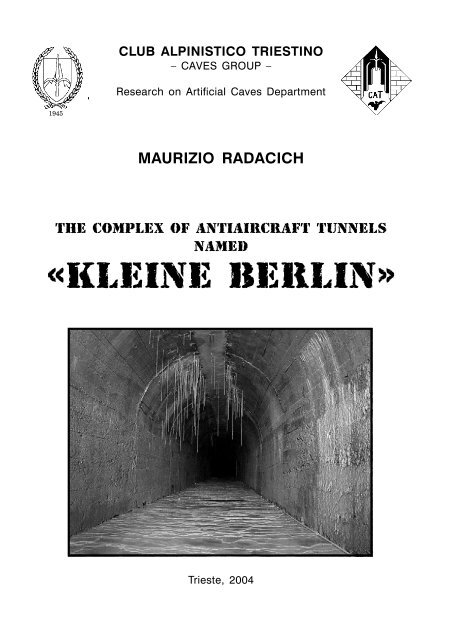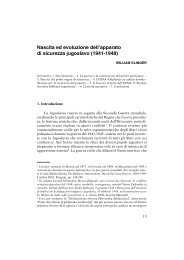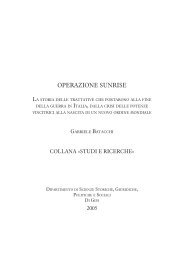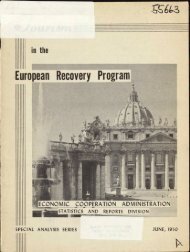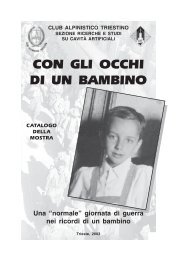Kleine Berlin libretto inglese.pmd - Club Alpinistico Triestino
Kleine Berlin libretto inglese.pmd - Club Alpinistico Triestino
Kleine Berlin libretto inglese.pmd - Club Alpinistico Triestino
Create successful ePaper yourself
Turn your PDF publications into a flip-book with our unique Google optimized e-Paper software.
CLUB ALPINISTICO TRIESTINO– CAVES GROUP –Research on Artificial Caves Department1945MAURIZIO RADACICHTHE COMPLEX OF ANTIAIRCRAFT TUNNELSNAMED«<strong>Kleine</strong> <strong>Berlin</strong>»Trieste, 20041
Walking up along via Fabio Severo,on the side of the petrol station,you can notice the entranceof four tunnels on the wall belowvia di Romagna.These are the access to the complexof antiaircraft tunnels named“<strong>Kleine</strong> <strong>Berlin</strong>”, built during WorldWar II.The complex of antiaircraft tunnels“<strong>Kleine</strong> <strong>Berlin</strong>” consists of four interconnectedantiaircraft shelters.Three of them were meant to protectthe Italian civilian population,whereas the fourth is an antiaircraftshelter destined to German civiland military staff.Historical premisesPiazza Vico. On the background, the roadtunnel with its anti-splinter wall.(g.c. Fulvia Bax)2On June 10, 1940 Italy declaredwar on France and Britain, thusgetting involved in World War IIwith Germany as its ally.The Minister for Home Affairs orderedto build public shelters forthe civilians on a national scale, incase of air-raid of the enemy airforce.Originally, public antiaircraft sheltersconsisted of silted up trenchesand, in case of buildings with archedunderpasses, of anti-splinterwalls.Besides, all public buildings shouldinclude domestic and anti-bombshelters.Apart from some small railroad tunnels,at that time there were tworoad tunnels in Trieste: the Sandrinelliand the San Vito tunnels. Heresome public shelters were arranged,incorporating anti-splinterwalls at the entrance. Masonriescollocated on rails allowed the freemovement of public and privatetransports in tunnels, when theantiaircraft alarm did not go off. Itemerged that such tunnels couldshelter a high number of people.For this reason the Trieste administrationconsidered the possibilityof creating tunnels to shelter civilians.Besides, these sheltersshould be used in the post-war periodtoo, with two entrances, destinedto become road or pedestriancrossings connecting different partsof the city.The orographic conformation of Tri-
este - situated on marl and sandstonehills - allowed to build manyantiaircraft shelters in tunnels. InDecember 1942 the Trieste authoritiesdecided to build three antiaircraftshelters for the civilian population,among which the “Scorcolahill” shelter.The “Scorcola hill” shelterThe project for the “Scorcola hill”antiaircraft complex included amain tunnel starting at Roiano invia Sara Davis. It was meant toreach the present via Tibullo nearthe Military Hospital, including twolateral exits, the first near the squarePiazzetta Belvedere, the otherin via Fabio Severo.The Emilio Colombo company fromComo was entrusted the works. Atthat time it availed itself of aworkforce of about 150 workers,most of them from Veneto andFriuli regions. The building of thetunnel started in early 1943 withthe creation of four adits.Until May 1943 only the Colombo2.20.1943 – Via Catullo (now via Tibullo),foreground trench.5.22.1943 – Via Catullo. Cribbing of thetunnel’s entrance.3.2.1944 – Via Catullo. Anti-splinter wall.The shelter of Piazzetta Belvedere.3building yard could be seen alongvia Fabio Severo, while excavatingthe “municipal” antiaircraft tunnelin the massive wall of via di Romagna.Today this is the III entranceof <strong>Kleine</strong> <strong>Berlin</strong>. Starting from June
the works in via Fabio Severo wereintensified. Another tunnel was tobe opened in the massive wall ofvia di Romagna: the Railway Servicetunnel (I entrance).During the war the works at the“municipal” tunnel had to beslowed down and the originalproject was never completed.Three tunnels were built from the“Scorcola hill” project: the oneconnecting Roiano with via Tibulloand two other tunnels, which hadto be its lateral exits (PiazzettaBelvedere and via Fabio Severo).However, they were never connectedwith the main one.There are two main reasons for theincompletion of the project. Firstly,the bombing of June 10, 1944,when one third of Colombo companyworkers did not show up andremained in their hometowns, thushampering a successful excavation.The remaining workers wereinvolved in clearing the wreckage.Secondly, and more importantly,after this emergency work theColombo workers were forcedlyrecruited by the Germans and orderedto build their antiaircraftshelters.The tunnels of the Railways andof the Post ServiceIn summer 1943 the Colombo com-2.5.1943 – Via Fabio Severo. Drive tunnel of the municipal tunnel.4
pany was working at the tunnel invia Fabio Severo. At that time, theTrieste authorities were asked bythe Railway Service the permissionto build another tunnel, parallel tothat already on the stocks. It hadto be used exclusively by the Railwaysstaff.The Giuliani company of Triestewas assigned the building of thistunnel. When the works started, thePost administration asked the Railwaysthe permission to build athird tunnel, parallel and communicatingwith the other ones, to beused by its staff. The Post servicealready had the license to start thebuilding.In early September 1943 two buildingyards were operating in viaRamification leading to the civil antiaircrafttunnels destined to the Railways staff.Fabio Severo. When the alarm signalswent off, the building companieswere obliged to let the civiliansin the shelters. Alarmscontinued on a daily basis, wheneverAllied aircrafts flew aboveTrieste, heading for Austria or Germany.The people of Trieste wasconvinced that their city was nevergoing to be bombed. Therefore,each time the alarms went off, themajority did not enter the shelters.The most cautious shew up at theentrance of the tunnels to be sheltered,thus hampering the works.However, the excavations continuedin the interior of the tunnels,causing discomfort to the people2.24.1944 – Via Fabio Severo. Antiblow wall. sheltered.5
The “Adriatic Coastline”Operational ZoneThe Armistice of September 8,1943 between Italy and the Alliesresulted in the occupation of Nazitroops.On October 15, 1943 the peopleof Trieste learned from the dailynewspaper “Il Piccolo” that theircity, together with Ljubljana, Rijeka,Udine and Gorizia had been includedin a new territory under Germanrule. Such new territorial jurisdictionwas called “AdriatischesKüstenland” (Adriatic CoastlineOperational Zone). The civil powerwas to be exerted by FriedrichRainer, the Gauleiter of Kärntenregion. Trieste became the headquartersof this new “province”.The SS Gruppenführer Odilo LotarioGlobocnik, born in Trieste, SanGiovanni, in 1904, was called tolead the Police and continue theanti-partisan struggle.Globocnik, who worked at theCourt, confiscated Angelo Ara’svilla in via di Romagna, transformingit into its own residence.Today this place hosts a condominiumat N. 28.The German antiaircraft shelterAfter creating the “Adriatic CoastlineOperational Zone”, the Germansstarted to build a high numberof military defenses. The works4.20.1944 – Parade organized in Trieste to celebrate Adolf Hitler’s birthday.6
Odilo Lotario Globocnik.were carried out by some companiescooperating with Todt, a Germanorganization. Many workswere carried out on the territory. Inparticular, the German authoritieswanted to start the building of anantiaircraft shelter for their soldiersand civil employees operating inthe Trieste Court area.The creation of the shelter was notof the utmost importance, becausewhen the alarm signal went offsoldiers used to flee with the Italiancivilians into the “municipal”tunnel, which was on the stocks.To that end, the Nazi authoritieshad supplied the lighting installationof the shelter. Therefore, the“municipal” tunnel was equippedwith an electric system made upof bare copper wires – accordingto the German use – instead ofThe Court Palaceafter the city fight. May 2 nd , 1945.7
IThe entrance of the first tunnel(Railways Service shelter)IIIIIThe entrance of the second tunnel(Post Service shelter)8IVThe entrance of the third tunnel(Municipal shelter)13The entrance of the fourth tunnel(German shelter)84
9107562THE COMPLEX OF ANTIAIRCRAFTTUNNELS NAMED«<strong>Kleine</strong> <strong>Berlin</strong>»9
4.20.1944. Nazi military parade. On the left,a water basin to be used in case of fire.(Photo by A. Umek)bare lead wires, employed in otherantiaircraft tunnels of Trieste.The excavation of the shelter involvedthree different companies,and each of them should ignorethe activity of the other two. GeneralGlobocnik had imposed themto work in secrecy, because he hadthought of creating a “secret passage”between his house and theCourt. As a matter of fact, the shelter’sentrance of via Fabio Severo,close to the street leading to via diRomagna, as well as the passageleading to the Court of Trieste werebuilt by land-surveyor Gerdol’scompany, which worked on behalfof Todt. The main tunnel and the10lateral ramifications of the complexGerman antiaircraft shelter wasprobably entrusted to Todt’s companyMazorana & Co. The passageconnecting Globocnik’s VillaAra with the ceiling of a lateraltunnel of the antiaircraft shelter wascarried out by the Schwarz company,also working for Todt.After the bombing of June 10, 1944the building of the shelter becamecrucial. Therefore, the Germans orderedthe workers of the Colombocompany to collaborate with Todtin the excavation of their antiaircraftshelter, with a wide use ofmines.Some inscriptions found in the tunnelused by the Germans and reachingvia Fabio Severo (IV entrance,where guided tours start)suggest that the main works werefinished in December 1944. Withno doubt, trimming works continueduntil the end of the war andfor this reason were never completed.Evidence to this, current generatorswere never installed, evenif cement basement are still visiblein two places.As regards the illumination of theshelter, the Germans had a servicepipe connected to the thenpublic utilities company ACEGAT.As a matter of fact, an electric distributionpanel, still visible today,was installed near the entrance,along a passage reaching the maintunnel of the shelter.Ancillary light, which was activatedin case of lack of electricity,
was provided by accumulatorsconfiscated to fishing vessels,which before the war used to fishaccompanied by night-fishing boats.The entrance to the antiaircraftshelter was forbidden to any non-German staff. No Italian was allowedto enter it, exception madefor an electrician working for theLuigi Presel company, in charge ofreplacing burnt out lamps, and forsome other people working for theGermans.The Germans’ main concern as forthe management of the shelter wasthe high amount of humidity stagnatingin the tunnels. Therefore,they decided to resort to braziersburning coke coal in order to dryup the rooms. Unfortunately, allGerman antiaircraft shelters lackedan air change device. Therefore,burnt gas was conveyed throughan expelling fan to the “municipal”tunnel, causing serious problemsof asphyxia for the people sheltered.Documents at the Municipalityof Trieste General Archives witnessthe fact that Mayor CesarePagnini asked the Deutscher Berater(intermediate German counsellorbetween the Municipality andthe Gauleiter Rainer) to forbid braziersin the German shelter.In the night of April 29, 1945, GauleiterRainer and general Globocnikabandoned Trieste and left forAustria. Here they were arrested bythe Allies. On April 30, 1945 an insurrectionburst out in Trieste ledby the National Liberation Committee.On May 1 st the partisan Jugoslav<strong>Kleine</strong> <strong>Berlin</strong>. What remains of the electricdistribution panel in the German shelter.(Photo by R. Bernardis)11<strong>Kleine</strong> <strong>Berlin</strong>. Lamp used in municipalantiaircraft shelters. (Photo by R. Bernardis)
troops entered the city, surroundingthe last German strongholdsand forcing German soldiers to surrender.The Court, connected toThe present entrance of “<strong>Kleine</strong> <strong>Berlin</strong>” (onthe left) at the Allies arrival. You can noticethe cement cowling, later demolished.5.3.1945 – On the left, near the parapetbetween via Fabio Severo and via diRomagna, you can notice the entrance of theGerman shelter. (Photo by F. Harwey)the antiaircraft shelter, was amongthese strongholds. No trace of aJugoslav attempt to penetrate thecorridor of the Court has beenfound. Probably, nobody knewabout this passage. The city fightdid not last long, German soldierssurrendered to New Zealand troops,that in the meantime hadentered the city. After twenty months,the German occupation of Triesteterritory came to an end.5.3.1945 – Barracks of the buildingcompanies along via Fabio Severo.(Photo by F. Harwey)Brief description of the roomsThe visit of the “<strong>Kleine</strong> <strong>Berlin</strong>” complexbegins at the entrance reservedto German soldiers (IV entrance).12
At that time, the access was equippedwith a cement military cowling,destroyed in 1948 by the TriesteDeminers Group. On that occasion,the main entrance of the shelterwas silted up too. This entrancewas camouflaged by a cementconstruction and located where thesidewalk below the masonry connectsvia Fabio Severo with via diRomagna.Walking down the first section ofthe tunnel you arrive at a crossing(1); going straight forward you arriveat a room where a cementbasement for a current generatorwas collocated (2). Before enteringthe room, a little passage on theright leads to a door.After the door, a slightly descendingpassage leads to the formerRamification leading to the Court (on theright). On the left, you can reach the maintunnel.main entrance of the German antiaircraftshelter (3).Then you turnleft, walk on and turn right until youget to the barrage obstructing theaccess to the hypogeal rooms ofTrieste Court (Palazzo di Giustizia)Gate of the current IV entrance.The first section of the tunnel, after theentrance.13
The main tunnel.(Photo by P. Omari)(4). During visits, groups are rarelyallowed to visit this section ofthe tunnel because it is full ofwater.Back to position 1, you walk downthe left corridor until you comeacross the main tunnel (5), fromwhich eleven lateral ramificationsbranch off. The ramifications on theright side are all about 26 metreslong (6), while the ones on the leftside are between 12 and 25 metreslong, exception made for thepassage employed for sanitationservices (7), which is less than 10metres long.Among these tunnels, one is equippedwith a well on its vault. Suchwell was then equipped with a windingstaircase (8), used by generalGlobocnik to reach his workplaceat the Court from his houseof Villa Ara.At the end of the long “German”tunnel, a door (9) leads into themunicipal antiaircraft shelter (10),consisting of a 250 metres tunnel,built by the Emilio Colombo com-Masoned wall in the tunnel leading to theCourt.The sanitation services. (Photo by P. Omari)14
The “Globocnik well”.pany on behalf of the Municipalityof Trieste.Here you can realize to what extentnature is slowly, though inexorably,taking possession of thehypogeum again. A fascinatingscenario comes into sight, thrivingSection of the municipal tunnel. Concretionsare visible on the walls and on the ground.The door of the adjacent municipal antiaircraftshelter.15Via Fabio Severo. Excavation interrupted inthe municipal tunnel. (Photo by R. Bernardis)
Stalagmite concretions on the ground of theItalian tunnels.with stalactites, stalagmites andconcretion cups, veiled by ceaselesslyflowing water. This phenomenonis not so visible in theGerman section and is due to thefact that the last part of the Italiantunnel was never cemented.The final result is extremely pleasant,giving the impression ofbeing in a natural karst cave, insteadof an artificial hypogeum.And what’s more, the site is locatedin the very city centre of Trieste.RAIPIAZZA OBERDANENTRANCEPVIA FABIO SEVEROPCOURTVIA CORONEOInformation available at:CLUB ALPINISTICO TRIESTINOVia Raffaele Abro, 5/A – 34144 TriestePhone: 040 3498239 (on Tuesdays and Thursdays 9 p.m. – 11 p.m.)Fax: 040 8326424 - e-mail: cat@cat.ts.it – www.cat.ts.it16


